Airway Study guides, Class notes & Summaries
Looking for the best study guides, study notes and summaries about Airway? On this page you'll find 57882 study documents about Airway.
All 57.882 results
Sort by
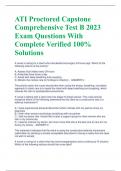 Popular
Popular
-
ATI Proctored Capstone Comprehensive Test B 2023 Exam Questions With Complete Verified 100% Solutions
- Exam (elaborations) • 34 pages • 2023
- Available in package deal
-
- $15.89
- 40x sold
- + learn more
ATI Proctored Capstone Comprehensive Test B 2023 Exam Questions With Complete Verified 100% Solutions A nurse is caring for a client who had abdominal surgery 24 hours ago. Which of the following actions is the priority? A. Assess fluid intake every 24 hours B. Ambulate three times a day C. Assist with deep breathing and coughing D. Monitor the incision site for findings of infection - ANSWER C The priority action the nurse should take when using the airway, breathing, circulation...
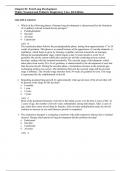 Popular
Popular
-
Test Bank for Neonatal and Pediatric Respiratory Care, 6th Edition by Brian K. Walsh
- Exam (elaborations) • 207 pages • 2023 Popular
-
- $39.99
- 28x sold
- + learn more
Test Bank for Neonatal and Pediatric Respiratory Care, 6th Edition 6e by Brian K. Walsh. Full Chapters test bank are included - Chap 1 to 42 (Complete chapters with answers) Section 1: Neonatal Part 1: Fetal Development, Assessment, and Delivery 1. Fetal Lung Development 2. Fetal Gas Exchange and Circulation 3. Antenatal Assessment and High-Risk Delivery 4. Respiratory Care in Pregnancy Part 2: Assessment and Monitoring of the Neonate 5. Examination and Assessment 6. Radiographic Asse...
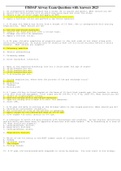
-
FISDAP Airway Exam Questions with Answers 2023
- Exam (elaborations) • 11 pages • 2023
- Available in package deal
-
- $14.99
- 16x sold
- + learn more
FISDAP Airway Exam Questions with Answers 2023
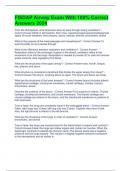
-
FISDAP Airway Exam With 100% Correct Answers 2024
- Exam (elaborations) • 15 pages • 2024
- Available in package deal
-
- $14.99
- 3x sold
- + learn more
FISDAP Airway Exam With 100% Correct Answers 2024
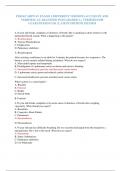
-
FISDAP AIRWAY EXAMS 2 DIFFERENT VERSIONS ACCURATE AND VERIFIED | GUARANTEED PASS GRADED A | VERIFIED FOR GUARANTEED PASS | LATEST EDITION| 2023/2024
- Exam (elaborations) • 30 pages • 2023
- Available in package deal
-
- $17.99
- 1x sold
- + learn more
FISDAP AIRWAY EXAMS 2 DIFFERENT VERSIONS ACCURATE AND VERIFIED | GUARANTEED PASS GRADED A | VERIFIED FOR GUARANTEED PASS | LATEST EDITION| 2023/2024
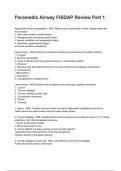
-
Paramedic Airway FISDAP Review Part 1 Exam 2024 Already Graded A.
- Exam (elaborations) • 62 pages • 2024
- Available in package deal
-
- $10.49
- 2x sold
- + learn more
Paramedic Airway FISDAP Review Part 1 Exam 2024 Already Graded A.
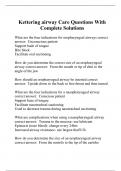
-
Kettering airway Care Questions With Complete Solutions
- Exam (elaborations) • 11 pages • 2023
- Available in package deal
-
- $11.49
- 1x sold
- + learn more
What are the four indications for oropharyngeal airways correct answer: Unconscious patient Support bade of tongue Bite block Facilitate oral suctioning How do you determine the correct size of an oropharyngeal airway correct answer: From the mouth or tip of chin to the angle of the jaw How should an oropharyngeal airway be inserted correct answer: Upside down to the back to free throat and then turned What are the four indications for a nasopharyngeal airway correct answer: C...
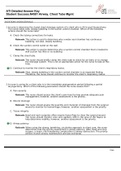
-
ATI Detailed Answer Key Student Success.N4581 Airway. Chest Tube Mgmt
- Exam (elaborations) • 14 pages • 2022
-
- $14.99
- 16x sold
- + learn more
ATI Detailed Answer Key Student Success.N4581 Airway. Chest Tube Mgmt QUESTIONS AND RATIONALE 1. A nurse is observing the closed chest drainage system of a client who is 24 hr post thoracotomy. The nurse notes slow, steady bubbling in the suction control chamber. Which of the following actions should the nurse take? A. Check the tubing connections for leaks. Rationale: This action is used to determine why a water seal chamber has continuous bubbling, not slow, steady bubbling. B. Check ...
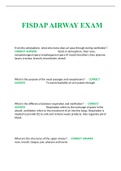
-
FISDAP AIRWAY EXAM
- Exam (elaborations) • 32 pages • 2023
- Available in package deal
-
- $12.49
- 1x sold
- + learn more
FISDAP AIRWAY EXAM From the atmosphere, what structures does air pass through during ventilation? - CORRECT ANSWER Starts in atmosphere, then nose, nasopharyngeal space/orophargyneal space (if mouth breather), then pharynx, larynx, trachea, bronchi, bronchioles, alveoli What is the purpose of the nasal passages and nasopharynx? - CORRECT ANSWER To warm/humidify air as it passes through

-
FISDAP Airway Exam Practice Questions with Answers 2021/2022
- Exam (elaborations) • 15 pages • 2022
- Available in package deal
-
- $16.99
- 18x sold
- + learn more
FISDAP Airway Exam Practice Questions with Answers 2021/2022
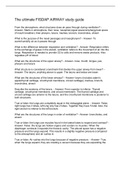
-
The ultimate FISDAP AIRWAY study guide
- Exam (elaborations) • 98 pages • 2023
-
- $14.99
- 1x sold
- + learn more
From the atmosphere, what structures does air pass through during ventilation? - Answer- Starts in atmosphere, then nose, nasopharyngeal space/orophargyneal space (if mouth breather), then pharynx, larynx, trachea, bronchi, bronchioles, alveoli What is the purpose of the nasal passages and nasopharynx? - Answer- To warm/humidify air as it passes through What is the difference between respiration and ventilation? - Answer- Respiration refers to the exchange of gases in the alveoli, ventilat...
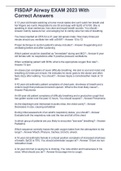
-
FISDAP Airway EXAM 2023 With Correct Answers
- Exam (elaborations) • 5 pages • 2023
- Available in package deal
-
- $11.49
- 7x sold
- + learn more
FISDAP Airway EXAM 2023 With Correct Answers

$6.50 for your textbook summary multiplied by 100 fellow students... Do the math: that's a lot of money! Don't be a thief of your own wallet and start uploading yours now. Discover all about earning on Stuvia


